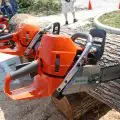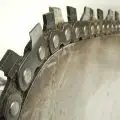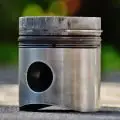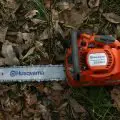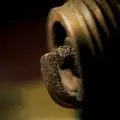Chainsaws are no stranger to emitting smoke sometimes for various reasons. For new chainsaw users, this can be very confusing, as they will not know whether this is normal or not. But why do they smoke?
Are chainsaws supposed to smoke? No, they definitely aren’t. Although it isn’t normal for a chainsaw smokes, people often come across this issue.
It can be as simple as the result of the chainsaw overheating, the chainsaw’s fuel mix containing too much oil, or the chain having insufficient lubrication or not being sharp enough.
As you can guess, a smoking chainsaw is a sure sign that something isn’t working as it should.
Sure, there is a bit more to it than that, and this article will provide you with all the relevant information for understanding the cause behind the smoke so that you can fix the problem.
Table of Contents
- Why Is My Chainsaw Smoking?
- Chainsaw Blade Smoking
- Black Smoke Exiting the Exhaust Port
- Chainsaw Smoking From the Engine
- Electric Motor Engine Chainsaw Smoking
- FAQs
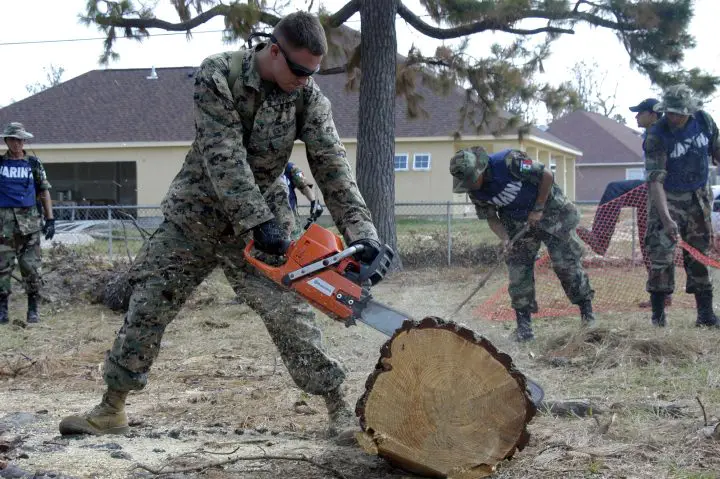
Why Is My Chainsaw Smoking?
As we’ve learned already, a chainsaw can smoke for several different reasons. Checking where the smoke is coming from is definitely the easiest way to determine the cause.
Once you have found the source, the list of possible causes can be narrowed down and you will be able to begin fixing the issue before your chainsaw gets severely damaged.
Here’s a list of different Chainsaw smoking scenarios:
- Chainsaw blade smoking
- Black smoke exiting the exhaust port
- Chainsaw smoking from the engine
- Electric motor engine chainsaw smoking
We’ll take a look at each in more detail throughout this article!
Chainsaw Blade Smoking
This scenario is pretty easy to differentiate from the others because you will only discover the chainsaw blade smoking or the chainsaw’s chain smoking.
The chainsaw smoking when cutting will only start when you have initiated some cutting with it. It’s likely that the chain is generating too much friction while cutting which therefore causes it to emit some smoke.
Wooden scraps generated from cutting can literally burn away due to the heat generated by the chain, which would lead to smoke coming from the blade or chain.
In addition to this, if you are cutting wet wood, the water contained inside it can also evaporate which is very easy to mistake for smoke, especially in extremely cold weather.
Now, the question is, why does the chain generate so much heat that the chainsaw smokes? Well, here are the two main reasons for this:
- The chain has insufficient lubrication
- The chain isn’t sharp enough
The Chain Has Insufficient Lubrication
Before any operation or task with the chainsaw, you should check to see if the chainsaw has adequate bar oil in its tank. If it’s empty or low, you should top it off and hopefully, the problem will go away.
In some cases, however, the bar oil isn’t getting onto the guide bar or isn’t getting distributed along the chain properly leading to the chainsaw bar smoking.
To check if this is definitely the issue, first of all, place a piece of paper on the ground. Then start up your chainsaw and hold the edge of the guide bar above the paper while rotating the chain.
If everything is in working order, you will likely see a steady stream of tiny oil drops appearing on the paper. On the other hand, if you don’t see any oil drops, then you have an issue with the bar oil flowing through the guide bar.
How to Fix Insufficient Lubrication to Chainsaw Guide Bar
The most common reason for this issue occurring is clogged channels that are responsible for distributing the oil. These will gradually become clogged by wooden scraps or other forms of very fine dust particulates.
If you first remove the chain from the guide bar, you should be able to see a thin channel on it right below where the chain was previously. Grab a small screwdriver or paper clip or whatever that fits in there, and see if you can pick/scrape any wooden dust out of it.
This thin channel being clogged is detrimental to the bar oil’s flow, so you must make sure to remove all wooden scraps and dust from it.
If you have cleaned the oil channel on the guide bar and the problem is still persisting, it’s likely that the chain probably isn’t getting any oil to begin with.
To check if this is definitely the case, you will need to remove the guide bar from your chainsaw to get to the oiler which is located below it. I’d recommend checking your user manual if you aren’t 100% sure what to look for, as they can be slightly different for every manufacturer.
After removing the guide bar successfully, fire up your saw and begin running the engine. Now, you should see a steady stream of oil flowing from the oiler port, but if this isn’t the case then the port may be clogged by wooden scraps.
Cleaning the port will fix the problem if it is clogged, but if it isn’t, and oil still isn’t flowing, then we may have a different mechanism that is broken. This is where I advise taking your chainsaw to a nearby service center to have it looked at by a professional.
The Chain Isn’t Sharp Enough
Probably more likely to be the reason that the first case presented, is the use of an older chain that hasn’t been sharpened for a while.
If the chain is blunter than it should be, it will generally need a lot more time to cut through wood than it would under optimal conditions, therefore, generating a lot of needless additional friction throughout the process.
This friction will rapidly warm up both the wood you are cutting and the chain itself, resulting in the chainsaw smoking when cutting.
It’s pretty simple to judge if your chain isn’t sharp enough. Normally, by just placing the chainsaw on a piece of wood it should be enough for the blade to bite into it, without the need for any applied additional force, by yourself.
Another check you can conduct is the size of the wooden scraps that are left over when you’re cutting. They should normally be leaving big scraps, however, if your chain is dull it will only leave wooden dust on the floor.
How to Fix Dull Chainsaw Blades
You can fix this problem by simply sharpening the blades on your chain. The easiest way to do this is to buy a chain sharpener which is sold by most chainsaw manufacturers. Alternatively, if your chain is beyond saving, you can buy a new chain.
Black Smoke Exiting the Exhaust Port
Black smoke exiting the exhaust port is usually the result of the fuel mixture having too much oil in it. Most chainsaws nowadays tend to use the 1:50 oil/fuel mix, but you should always check your user manual to ensure, as it can be different for varying chainsaw brands.
Having too much oil in the chainsaw isn’t that dangerous to your chainsaw, but it may certainly have performance issues and of course, it will therefore use more oil and fuel than it is designed to.
How to Fix Black Smoke Exiting Exhaust Port
To fix this black smoke exiting your exhaust port, you will first need to drain the fuel mixture with the incorrect oil ratio from the tank.
Then you can prepare a fuel mixture with the correct ratio before putting it into the chainsaw’s fuel tank. Now, run the chainsaw for a few minutes and the black smoke should disappear.
Alternatively, and significantly more difficult, you could try to amend the mixture that you drained from the tank by adding more fuel to it to get the right ratio. But this, of course, requires you to know the exact oil ratio you used previously so that you can calculate the exact amount of fuel you need to add.
If you aren’t sure about it, then I certainly would not risk it if I were you. As you know, if you get it wrong, not having enough oil in the fuel mixture will ruin your engine.
Chainsaw Smoking From the Engine
This is usually the sign of some more serious issue – one that can ruin your chainsaw if it doesn’t get fixed. There are two main ways this problem can present itself:
- The chainsaw smoking on startup
- The chainsaw smoking during usage
The Chainsaw Smoking on Startup
If your chainsaw starts smoking on startup, this is usually a sign that the engine is running lean, meaning that it isn’t getting enough fuel for the amount of air it’s consuming.
This can easily cause problems in the long term as it will overheat your engine, and eventually ruin it.
How to Fix Chainsaw Smoking on Startup
To fix this, you will need to adjust the chainsaw’s carburetor so that it can provide more fuel to the engine.
The process of doing this will vary for each chainsaw brand, but it is typically done with a screwdriver. Refer to your user manual to follow your specific guidelines.
Also, you should check to see if they provide any recommendations for the optimal settings for various temperatures. This could save you a lot of time compared to trying to figure out what works on your own.
The Chainsaw Smoking During Usage
If your chainsaw starts smoking during usage, it is likely that your chainsaw is overheating. This is a serious issue and should not be ignored, as it can ruin your chainsaw in a very short amount of time.
This can be the result of many things, but the main three are:
- Insufficient oil in the fuel mix
- Clogged exhaust port
- Clogged air filter
Also, the chain not being sharp enough or simply cutting a tree that is too big for your saw can also be contributing factors.
Without sufficient oil in the fuel mix, the pistons will start grinding on the insides of the engine, generating a lot of heat in the process that will inevitably ruin the engine.
Chainsaws, just like cars, have an exhaust port where the fumes generated by the engine can exit the device. You usually don’t need to pay much attention to it, but if it gets clogged up by particulates, it can cause some serious problems.
The engine itself needs air to operate successfully. To prevent dust from getting into the engine, chainsaws will have an air filter installed. A lot of air passes through this filter while the engine is running, and over time it can accumulate a lot of dust particles.
Eventually, it will get to the point where clean air can no longer pass through due to the particulate build-up. When this happens, the engine will simply stop because it can’t operate without air. But before it stops, it will get hotter and hotter, due to the lack of fresh air.
Electric Motor Engine Chainsaw Smoking
If the motor of an electric chainsaw starts to smoke, it’s a sign that you have pushed it too far. In this situation, you should immediately stop the chainsaw and let it cool down.
The problem with this scenario is that by the time you notice it, it’s usually too late. If the chainsaw stops working while the motor is smoking and it isn’t able to start up again, then the motor is more than likely fried for good.
If you have somehow managed to stop the chainsaw in time, you should check if there is anything that may have caused the motor to overheat. First, check to see if the chain is getting sufficient lubrication, and make sure it’s sharp enough, as previously discussed.
Also, given that electric chainsaws are usually designed for smaller tasks, it is possible that whatever you tried to do was too heavy of a task. It, therefore, would be recommended to buy a bigger saw that can handle your tasks.
More chainsaw troubleshooting:
- How to Port a Chainsaw
- Are Chainsaw Bars Interchangeable
- How to Unflood a Chainsaw and Start It Once Flooded
FAQs
Why does my chainsaw smoke when cutting?
The most common reason for a chainsaw releasing smoke is a result of the chainsaw overheating, the chainsaw’s fuel mix containing too much oil, or the chain having insufficient lubrication or not being sharp enough.
Is it normal for a chainsaw blade to smoke?
No, it is not normal so you should definitely cease operation to diagnose and fix the problem immediately. If you are getting smoke from the chain when cutting it will most likely be low or no bar oil reaching the chain bar, so this should be your first inspection if your blades are sharp.
Why is my chainsaw smoking a lot?
A lot of smoke coming from the chainsaw will often indicate that an excessive amount of oil has been mixed into the oil and gasoline mixture causing the ratio to be off. You must ensure that you’re mixing the correct amount of oil and gasoline according to the advice provided in your owner’s manual.

